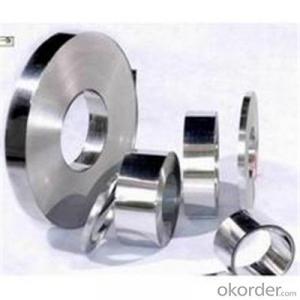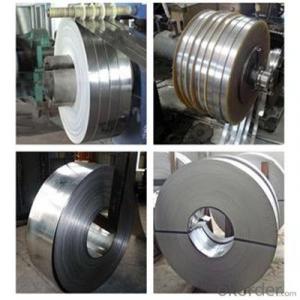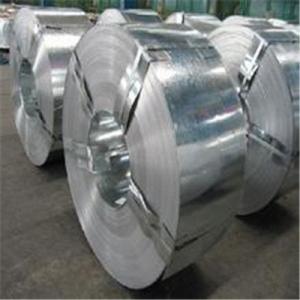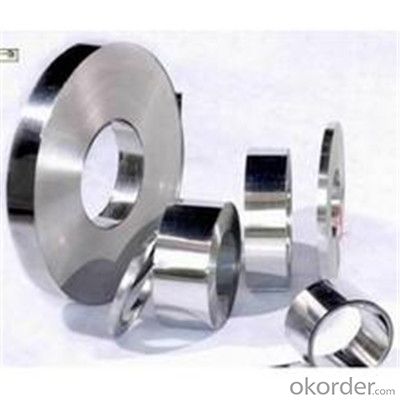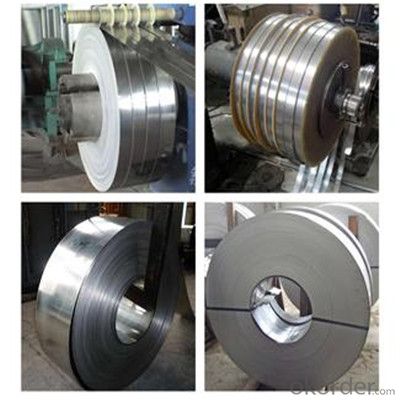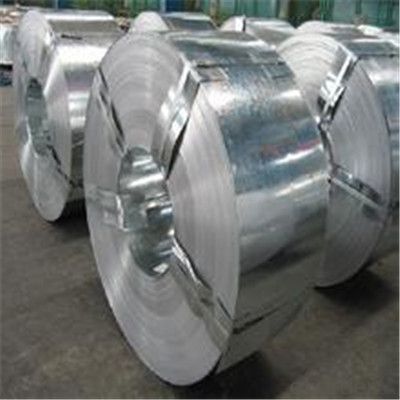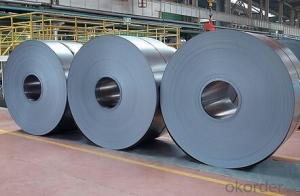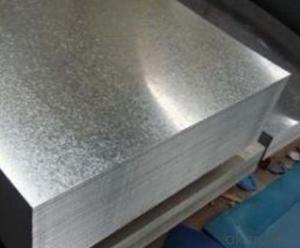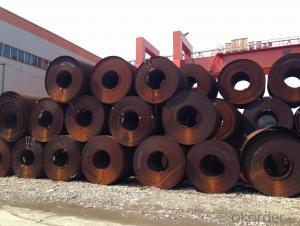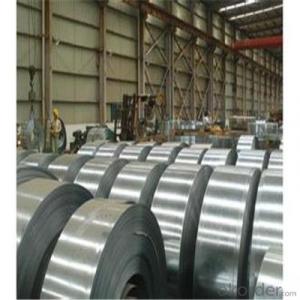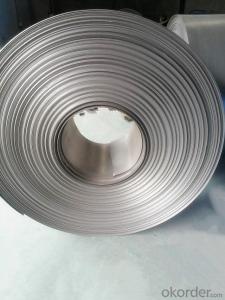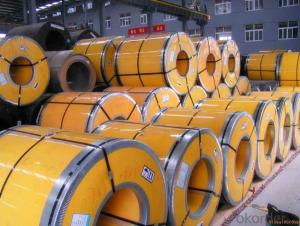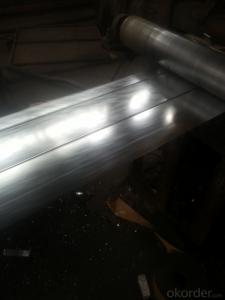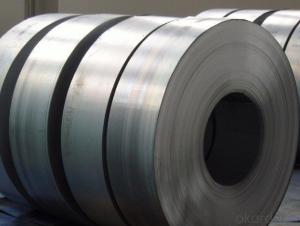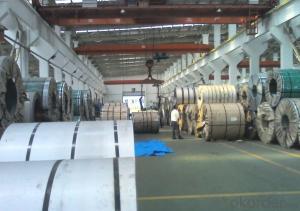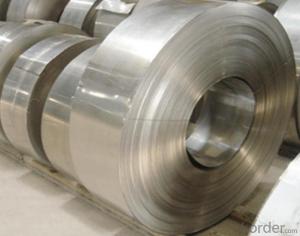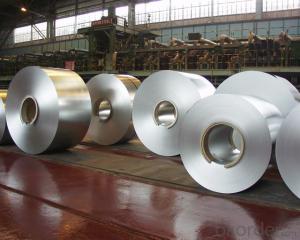Hot Rolled Steel Strip Coil with Hardened&Tempered
- Loading Port:
- Tianjin
- Payment Terms:
- TT OR LC
- Min Order Qty:
- 77 m.t.
- Supply Capability:
- 2222777 m.t./month
OKorder Service Pledge
OKorder Financial Service
You Might Also Like
Specification
Applications of Steel Strip Coils:
1:Chemical industry equipment, Industrial tanks
2:Medical Instruments,Tableware, Kitchen utensil,kitchen ware
3:Architectural purpose, Milk & Food processing facilities
4:Hospital Equipment, interior Exterior decoration for building
5:Architectural purposes, escalators, kitchen ware,vehicles
Festures of Steel Strip Coils:
1. Each coil is closely covered by oil paper or plastic film.
2. Outside it is firmly packed with sack cloth or compound paper.
3. Steel strap or PP strap to pack the outside to ensure safety.
4. On/about 1000kgs to be packed with one wooden pallet.
5. Strips can be loaded to 20'FCL without pallet if required by customer.
6. LCL shipment can also be arranged once required by the customer.
Specifications of Steel Strip Coils:
Hardened&tempred steel strip, high carbon 65Mn, HRC40-50,
used in hand saw, band saw, shutter door spring,
and various hardware tools.
Chemical compostions:C0.62-0.70% SI0.17-0.37% MN 0.90-1.20%
Images of Steel Strip Coils:

FAQ
1.What's your MOQ?
25MT, it is for one container.
2.Do you have QC teams?
Yeah, sure, our QC team is very important, they will keep the quality control for our products.
3. What's your normal delivery time?
Our delivery time about 10-20days for standard sizes, if you have other requirements like hardness and width ,it is about 20-40days.
- Q: How are steel strips used in the manufacturing of material handling equipment?
- Steel strips are commonly used in the manufacturing of material handling equipment for various purposes. One of the primary uses of steel strips is in the construction of frames and structures for these equipment. Steel strips provide high strength and durability, ensuring that the equipment can withstand heavy loads and operate efficiently in demanding environments. Steel strips are also used in the fabrication of components such as brackets, supports, and reinforcements. These components are crucial for the stability and functionality of material handling equipment. Steel strips can be easily shaped, cut, and welded, allowing manufacturers to create custom components that meet specific design requirements. In addition, steel strips are often used in the production of conveyor belts and chains for material handling equipment. These belts and chains are responsible for transporting goods, and steel strips provide the necessary strength and resistance to ensure smooth operation and long-lasting performance. Moreover, steel strips are utilized in the manufacturing of blades and cutting tools used in material handling equipment. These tools are essential for cutting, shearing, and shaping materials, and the strength and hardness of steel strips make them ideal for such applications. Overall, steel strips play a crucial role in the manufacturing of material handling equipment by providing strength, durability, and versatility. Their use in frames, components, conveyor belts, and cutting tools ensures that the equipment can handle heavy loads, withstand harsh conditions, and perform efficiently in various material handling operations.
- Q: How are steel strips used in the manufacturing of construction equipment?
- Due to their high strength, durability, and versatility, steel strips play a crucial role in the production of construction equipment. Throughout the manufacturing process, these strips are utilized in various ways. One way in which steel strips are commonly used is in the fabrication of structural frames. They are often employed to construct the primary framework of construction equipment such as bulldozers, cranes, and excavators. By cutting, shaping, and welding the strips together, a sturdy and robust structure is formed that can withstand heavy loads and operate in demanding conditions. In addition, steel strips are essential in the manufacturing of components such as buckets, blades, and cutting edges for construction equipment. These strips are shaped and formed into the desired shape to ensure that the resulting parts are strong enough to endure the intense forces and wear and tear experienced during construction operations. Moreover, steel strips are of great importance in reinforcing and strengthening attachments and accessories for construction equipment. For instance, they are utilized in the production of hydraulic cylinders, which are critical for the smooth functioning of machinery like cranes and forklifts. By rolling, machining, and welding the strips, cylinder bodies are created, providing the necessary strength and stability. Furthermore, steel strips are employed in the production of tracks and undercarriage components for construction equipment such as excavators and tractors. These strips are shaped into the form of tracks or other undercarriage parts, ensuring that the equipment can traverse various terrains and withstand heavy loads without compromising performance or safety. In conclusion, steel strips are an integral part of construction equipment manufacturing. Their strength, durability, and versatility make them ideal for constructing structural frames, components, attachments, and undercarriage parts. By incorporating steel strips into their manufacturing processes, companies can produce top-quality construction equipment that can endure the challenges of the job site and deliver exceptional performance.
- Q: How are steel strips stored?
- To prevent damage or deterioration, steel strips are commonly stored in a controlled environment. These strips are typically housed in clean, dry, and well-ventilated warehouses or storage facilities. They are placed on racks or shelves and each strip is labeled for easy identification and retrieval. To prolong the lifespan of the steel strips, they are often stored horizontally and neatly stacked on top of one another. This stacking method minimizes bending or warping. Sufficient space is maintained between each stack to allow for easy access and inspection. Moreover, heavy-duty packaging materials like wooden pallets or plastic wrapping are used to shield the strips from moisture, dust, and other contaminants. It is crucial to store steel strips away from corrosive substances or chemicals that could harm the material. Therefore, storage areas are typically separate from areas where such substances are present. Some storage facilities are equipped with climate control systems to regulate temperature and humidity, effectively preventing corrosion and other forms of degradation. Regular inspections are carried out to detect any signs of damage or deterioration, such as rust or deformation. Any compromised or damaged steel strips are promptly replaced or repaired to maintain the quality and integrity of the stored materials. Overall, the storage of steel strips requires meticulous organization, protection, and regular maintenance to guarantee their quality and suitability for various industrial applications.
- Q: What are the surface finishing techniques for steel strips?
- There are several surface finishing techniques that can be employed for steel strips, depending on the desired final product and its specific requirements. Some of the commonly used surface finishing techniques for steel strips include: 1. Pickling: This technique involves the use of an acid solution to remove any oxide scale or impurities from the steel strip's surface. Pickling helps in improving the strip's corrosion resistance and prepares it for further processing. 2. Electroplating: It is a process wherein a thin layer of metal is deposited onto the steel strip's surface using an electrolytic bath. Electroplating can enhance the appearance of the strip, improve corrosion resistance, and provide additional properties such as increased hardness or conductivity. 3. Galvanizing: This technique involves coating the steel strip with a layer of zinc to provide protection against corrosion. Galvanizing is commonly used in applications where the steel strip will be exposed to harsh environments. 4. Painting: Applying a layer of paint onto the steel strip's surface can provide both aesthetic appeal and protection against corrosion. Different types of paint coatings can be used, depending on the specific requirements of the application. 5. Grinding and Polishing: These techniques involve the use of abrasive materials to remove any imperfections or roughness from the steel strip's surface. Grinding and polishing can provide a smooth and reflective finish to the strip, which is desirable in certain applications such as decorative or reflective surfaces. 6. Coating: Various types of coatings, such as powder coatings or organic coatings, can be applied to the steel strip's surface to provide protection against corrosion, enhance appearance, or provide specific functional properties. 7. Heat Treatment: Certain heat treatment processes, such as annealing or tempering, can be employed to modify the surface properties of the steel strip. These processes can improve hardness, strength, or other mechanical properties of the strip's surface. It is important to note that the choice of surface finishing technique for steel strips depends on factors such as the desired final properties, application requirements, cost considerations, and environmental impact.
- Q: How are steel strips tested for dimensional accuracy?
- Steel strips are tested for dimensional accuracy using various methods and equipment. One common method is the use of precision measuring instruments such as calipers or micrometers to measure the length, width, and thickness of the strips. These instruments provide accurate measurements to ensure that the dimensions of the steel strips meet the required specifications. Another method used is optical measurement systems, which utilize cameras and laser sensors to capture the dimensions of the steel strips. These systems can quickly and accurately measure the dimensions of multiple strips simultaneously, making them suitable for high-volume production lines. In addition to direct measurements, steel strips can also be tested for dimensional accuracy using non-contact techniques such as laser scanning or optical profilometry. These methods create a 3D representation of the strip's surface, allowing for detailed analysis of its dimensions and shape. Finally, automated inspection systems can be employed to ensure the dimensional accuracy of steel strips. These systems use sensors and computer algorithms to detect any deviations from the specified dimensions and automatically reject faulty strips. This not only improves quality control but also increases the efficiency of the production process. Overall, the testing of steel strips for dimensional accuracy involves a combination of manual measurements, optical measurement systems, non-contact techniques, and automated inspection systems. These methods help ensure that the steel strips meet the required dimensional specifications, thus guaranteeing their quality and suitability for various applications.
- Q: How are steel strips used in the manufacturing of escalators?
- Steel strips are an integral component in the manufacturing of escalators. These strips are used in various stages of the escalator production process. Firstly, steel strips are used in the construction of the escalator frame. They are typically cut and shaped into specific dimensions to form the structural framework of the escalator. These strips provide the necessary strength and rigidity to support the weight of the entire escalator system. Additionally, steel strips are used in the manufacturing of the escalator steps. These strips are formed into a specific shape and size, often with a tread pattern for better grip and safety. The steps are then attached to the escalator frame, providing a stable and reliable surface for passengers to step on. Furthermore, steel strips are utilized in the creation of the handrails found on escalators. These strips are molded into a continuous loop, providing a durable and secure grip for passengers as they ride the escalator. The steel strips used for handrails are often coated with a layer of rubber or other materials to enhance comfort and grip. In summary, steel strips play a crucial role in the manufacturing of escalators. They are used in the construction of the escalator frame, the fabrication of steps, and the creation of handrails. Without steel strips, the production of safe and reliable escalators would be significantly compromised.
- Q: What are the safety precautions for handling steel strips?
- Some safety precautions for handling steel strips include wearing appropriate personal protective equipment (PPE) such as gloves and safety goggles to protect against cuts and flying debris. It is important to use proper lifting techniques and equipment to prevent strain or injury, and to ensure that the strips are stored and stacked in a stable manner to prevent them from falling or causing accidents. Regular inspection of the strips for any defects or sharp edges is also necessary to minimize the risk of injuries.
- Q: How do steel strips contribute to reducing overall production costs in various applications?
- Steel strips contribute to reducing overall production costs in various applications in several ways. Firstly, steel strips are highly durable and have a long lifespan, reducing the need for frequent replacements and repairs. This lowers maintenance costs and downtime, resulting in increased productivity and efficiency. Additionally, steel strips can be produced in large quantities quickly, making them cost-effective for mass production. Their versatility allows them to be used in a wide range of applications, eliminating the need for different materials and reducing inventory costs. Moreover, steel strips can be recycled, reducing waste and providing a sustainable solution. Overall, the cost-effectiveness, durability, efficiency, and recyclability of steel strips make them a valuable asset in reducing overall production costs in various applications.
- Q: How are steel strips used in automotive manufacturing?
- Steel strips are widely used in automotive manufacturing due to their strength, durability, and versatility. They are used in various components and parts of automobiles, playing a crucial role in ensuring the structural integrity and safety of vehicles. One of the primary applications of steel strips in automotive manufacturing is in the production of body panels. These strips are used to create the outer shell of vehicles, including doors, hoods, fenders, and roofs. The high tensile strength of steel strips helps to provide protection in case of accidents and impacts, while their ability to be shaped and formed into complex designs allows for the creation of aesthetically pleasing and aerodynamically efficient body panels. Steel strips are also used in the production of chassis and frame components. The chassis is the backbone of a vehicle, providing support and structural stability. Steel strips are used to create various structural components such as pillars, beams, and cross members, ensuring the overall rigidity and strength of the vehicle. Additionally, steel strips are often used in the manufacturing of suspension systems, which help to absorb shocks and vibrations, providing a smoother and more comfortable ride. Furthermore, steel strips are used in the production of engine components. These strips are used to create parts such as crankshafts, connecting rods, and camshafts, which are vital for engine performance and reliability. The high strength-to-weight ratio of steel strips allows for the creation of lightweight yet robust engine components, contributing to improved fuel efficiency and overall vehicle performance. In summary, steel strips play a vital role in automotive manufacturing by being used in the production of body panels, chassis and frame components, as well as engine parts. Their strength, durability, and versatility make them an ideal material for ensuring the structural integrity, safety, and performance of vehicles.
- Q: How do steel strips respond to different surface coating techniques?
- Different surface coating techniques can yield different responses from steel strips, depending on the specific method employed. Multiple options are available for coating steel strips, including galvanizing, electroplating, powder coating, and painting, each with its own strengths and weaknesses. Galvanizing, a commonly used technique, offers protection against corrosion by applying a layer of zinc onto the steel strip through hot-dip or electroplating processes. This coating provides exceptional durability and resistance to corrosion, making it well-suited for outdoor applications in industries such as construction, automotive, and infrastructure. Electroplating is another method used to add a thin layer of metal to the surface of steel strips. It can enhance the steel's appearance, improve corrosion resistance, or provide specific functional properties. Nickel, chromium, and tin are common metals used for electroplating steel strips. This technique ensures excellent adhesion and uniformity in the coating, resulting in a high-quality finish and protection against corrosion. Powder coating, a popular technique, involves the application of a dry powder onto the surface of the steel strip. The powder is then cured under heat, resulting in a durable and visually appealing coating. Powder coatings offer excellent resistance to corrosion and chemicals, as well as a wide range of color options. This technique is widely used in applications where aesthetic appeal is important, such as furniture, appliances, and architectural components. Painting, another commonly used technique, entails applying a liquid paint onto the surface of the steel strip, which subsequently dries to form a protective layer. Painting allows for a wide range of colors, finishes, and levels of protection against corrosion. However, it may not provide the same level of durability and resistance as other coating techniques, making it less suitable for harsh environments or heavy-duty applications. In conclusion, the response of steel strips to various surface coating techniques can vary. The choice of coating method depends on specific application requirements, such as corrosion resistance, durability, aesthetic appeal, and functionality. Each coating technique possesses its own advantages and limitations, necessitating careful consideration to select the most appropriate method for achieving the desired outcome.
Send your message to us
Hot Rolled Steel Strip Coil with Hardened&Tempered
- Loading Port:
- Tianjin
- Payment Terms:
- TT OR LC
- Min Order Qty:
- 77 m.t.
- Supply Capability:
- 2222777 m.t./month
OKorder Service Pledge
OKorder Financial Service
Similar products
Hot products
Hot Searches
Related keywords
